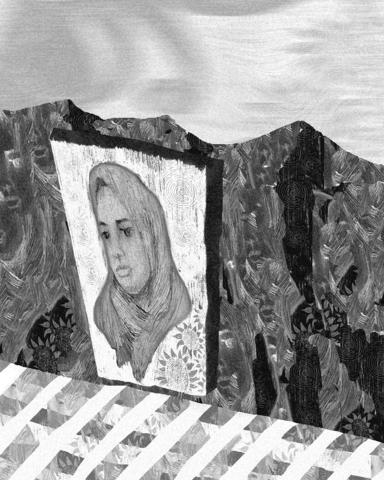The vivid sunsets painted by J.M.W. Turner are revered for their use of color and light and for their influence on the Impressionists. But could they also help global warming experts track climate change?
A group of Greek scientists has studied the colors in more than 500 paintings of sunsets, including many of Turner's 19th century watercolors and oils, in the hope of gaining insights into the cooling effects caused by major volcanic eruptions.
By better understanding past changes in climate, they hope to improve computer models for future climate change.

Christos Zerefos, who led the research at the National Observatory in Athens, said he believed it was the first scientific study of art for clues to past climate variations.
"The initial idea arose from the fact that we saw an increased reddening of colors in sunsets which followed large volcanic eruptions, particularly Krakatoa," Zerefos said.
The scientists studied works painted around the times of major volcanic eruptions, such as the cataclysmic eruption of Indonesia's Mt Krakatoa in 1883, to measure how much natural pollution those eruptions pumped into the skies.
Accounts from the time describe brilliant skies as the setting sun's rays were scattered through reflective dust and ash particles.
By measuring the amount of red and green in the paintings, the scientists aimed to calculate the amount of dust in the atmosphere. The greater the pollution, the redder the sunset, Zerefos said.
But Kevin Trenberth, who heads the Climate Analysis Research Center at the National Center for Atmospheric Research in Boulder, Colorado, and who is not connected to the study, warned that artists and scientists do not necessarily approach sunsets the same way.
"Painters are not scientists trying to do an accurate picture of nature," he said. "They are artists trying to make something look good or dramatic. A scope for embellishment presumably comes in."
TOO MUCH WEIGHT
And James Hamilton, the curator at the University of Birmingham who has written several books on Turner, said that while Turner had claimed to paint what he had seen, it was dangerous to put too much weight on an artist's interpretations at any one time.
"They [the artists] are not making absolutely clear and accurate records of what they can see," he said. "In many cases they are just working with that imagination as well, and it's very hard to tell when artists are being absolutely accurate and when they're using vivid sky as a platform to more vivid painting."
Scientists have long thought that major volcanic eruptions contribute to a process called global dimming, in which air pollution -- dust and ash from natural and industrial sources -- block the sun and have a cooling effect.
Some scientists believe that as pollution from industry is cleared, global warming could speed up.
Turner was particularly important in the study because he was alive during three eruptions, including the so-called "year without summer" after the eruption of Indonesia's Mount Tambora in 1815, which spewed out so much dust and ash that it caused widespread famine. The other two eruptions were of the Babuyan Claro volcano in the Philippines in 1831 and the Cosiguina volcano in Nicaragua in 1835.
Zerefos said his group was taking advantage of these artists' penchant to paint nature as they saw it. Turner, for example, once said he "wished to show what such a scene was like."
"They all may have different ways of painting, but the colors they used were representing the real environment." Zerefos said. "I was surprised to see that independent of the school or of the artist, a coherent picture is emerging slowly."
PAST STUDY
Paintings of skies have been used to study weather and atmosphere in the past, such as using Claude Monet's London series to look at pollution in the Industrial Revolution and Vincent Van Gogh's stars to study the night sky, said John Thorne, a professor of atmospheric meteorology at the University of Birmingham, who is not connected to the study.
But Thorne said that while there can be a worry about painters using artistic license, the study seems to average the possibility of artistic interpretation by using such a large cross section of artists.
"Some artists are very true to nature, some are very true to making up their own story. You have to understand the artist," Thorne said. "But they've used a huge cross section. So rather than a specific artist, they're more showing an average across all artists, and have showed that they are in fact subconsciously depicting what they see without necessarily realizing it."
Hamilton agreed, noting that: "The more artists and more known dates, the better."
The group obtained images of 554 paintings from 181 artists, including Edgar Degas, Gustav Klimt, Rembrandt, Thomas Gainsborough and Peter Paul Rubens. They then narrowed the list down to five artists, such as Turner, who were painting before, during and after the time of volcanic eruptions.
Computers were used to digitally measure the red-green ratio. Of the 54 paintings from times of volcanic eruptions, every case showed a significant reddening -- or pollution -- of the sky.
In the study, published in the journal Atmospheric Chemistry and Physics, Zerefos and his researchers wrote that the reddening of the paintings "can be tentatively attributed to the volcanic events and not to abnormalities in the color degradation due to age or other random factor."
The writers point out that their results are supported by independent historical accounts and other evidence such as measurements of dust particles trapped in ice cores.

As strategic tensions escalate across the vast Indo-Pacific region, Taiwan has emerged as more than a potential flashpoint. It is the fulcrum upon which the credibility of the evolving American-led strategy of integrated deterrence now rests. How the US and regional powers like Japan respond to Taiwan’s defense, and how credible the deterrent against Chinese aggression proves to be, will profoundly shape the Indo-Pacific security architecture for years to come. A successful defense of Taiwan through strengthened deterrence in the Indo-Pacific would enhance the credibility of the US-led alliance system and underpin America’s global preeminence, while a failure of integrated deterrence would
It is being said every second day: The ongoing recall campaign in Taiwan — where citizens are trying to collect enough signatures to trigger re-elections for a number of Chinese Nationalist Party (KMT) legislators — is orchestrated by the Democratic Progressive Party (DPP), or even President William Lai (賴清德) himself. The KMT makes the claim, and foreign media and analysts repeat it. However, they never show any proof — because there is not any. It is alarming how easily academics, journalists and experts toss around claims that amount to accusing a democratic government of conspiracy — without a shred of evidence. These
Taiwan is confronting escalating threats from its behemoth neighbor. Last month, the Chinese People’s Liberation Army conducted live-fire drills in the East China Sea, practicing blockades and precision strikes on simulated targets, while its escalating cyberattacks targeting government, financial and telecommunication systems threaten to disrupt Taiwan’s digital infrastructure. The mounting geopolitical pressure underscores Taiwan’s need to strengthen its defense capabilities to deter possible aggression and improve civilian preparedness. The consequences of inadequate preparation have been made all too clear by the tragic situation in Ukraine. Taiwan can build on its successful COVID-19 response, marked by effective planning and execution, to enhance
Since taking office, US President Donald Trump has upheld the core goals of “making America safer, stronger, and more prosperous,” fully implementing an “America first” policy. Countries have responded cautiously to the fresh style and rapid pace of the new Trump administration. The US has prioritized reindustrialization, building a stronger US role in the Indo-Pacific, and countering China’s malicious influence. This has created a high degree of alignment between the interests of Taiwan and the US in security, economics, technology and other spheres. Taiwan must properly understand the Trump administration’s intentions and coordinate, connect and correspond with US strategic goals.